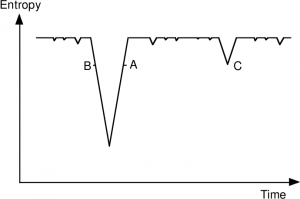This is an old text. See my book translated in English ‘Understanding Entropy in Light of a Candle‘: Classical thermodynamics. Statistical mechanics. What does physics say? Physics, mathematics and the world.
Chapter 3. The Arrow of Time in Statistical Mechanics: The evolution of Ludwig Boltzmann’s views. Loschmidt paradox and statistical foundations. Zermelo paradox and fluctuation hypothesis. Boltzmann’s Suicide. Statistical interpretation of the second law. Gibbs statistical entropy. Phase space mixing.
___
While reading Klaus Mainzer ‘Thinking in Complexity: The Computational Dynamics of Matter, Mind, and Mankind‘ I have seen a description of Boltzmann’s fluctuation hypothesis in Chapter 3.2 ‘Boltzmann’s Thermodynamics and the Evolution of Organisms‘.
I have read about this hypothesis when I have studied statistical thermodynamics long time ago. However it was a surprise for me that Boltzmann thought that the time arrow that we experience could be different from that of physical time. I have decided to search in Internet about this. Some quotes from two nice sources that I have found are below.
First a picture that will be referred to from both sources.

The main point is that provided that the physical time goes from left to right, Boltzmann had assumed that the lines A and B in the picture are equivalent and we cannot distinguish them. The line B corresponds to the case when the experienced time goes in the opposite direction to the physical time!
Huw Price, The Thermodynamic Arrow: Puzzles and Pseudo-Puzzles
“Boltzmann himself was one of the first to see the importance of this issue. In a letter to Nature in 1895, he suggests an explanation, based on an idea he attributes to ‘my old assistant, Dr Schuetz’. He notes that although low entropy states are very unlikely, they are very likely to occur eventually, given enough time. If the universe is very old, it will have had time to produce the kind of low entropy region we find ourselves inhabiting simply by accident. ‘Assuming the universe great enough, the probability that such a small part of it as our world should be in its present state, is no longer small,’ as Boltzmann puts it.”
“It is one thing to explain why the universe contains regions like ours, another to explain why we find ourselves in such a region. If they are so rare, isn’t it more likely that we’d find ourselves somewhere else? But Boltzmann suggests an answer to this, too. Suppose, as seems plausible, that creatures like us couldn’t exist in the vast regions of near-equilibrium between such regions of low entropy. Then it’s no surprise that we find ourselves in such an unlikely place. As Boltzmann himself puts it, ‘the … H curve would form a representation of what takes place in the universe. The summits of the curve would represent the worlds where visible motion and life exist.’”
“Why do we find ourselves on an uphill rather than a downhill slope, as at B? In another paper, Boltzmann offers a remarkable proposal to explain this, too. Perhaps our perception of past and future depends on the entropy gradient, in such a way that we are bound to regard the future as lying ‘uphill’. Thus the perceived direction of time would not be objective, but a product of our own orientation in time. Creatures at point B would see the future as lying in the other direction, and there’s no objective sense in which they are wrong and we are right, or vice versa. Boltzmann compares this to the discovery that spatial up and down are not absolute directions, the same for all observers everywhere.”
Sean Carroll, Boltzmann’s Anthropic Brain, Discover Magazine
To figure above. “You can see where this is going: maybe our universe is in the midst of a fluctuation away from its typical state of equilibrium. The low entropy of the early universe, in other words, might just be a statistical accident, the kind of thing that happens every now and then. On the diagram, we are imagining that we live either at point A or point B, in the midst of the entropy evolving between a small value and its maximum. It’s worth emphasizing that A and B are utterly indistinguishable. People living in A would call the direction to the left on the diagram “the past,” since that’s the region of lower entropy; people living at B, meanwhile, would call the direction to the right “the past.””
“The most basic problem has been colorfully labeled “Boltzmann’s Brain” by Albrecht and Sorbo. Remember that the low-entropy fluctuations we are talking about are incredibly rare, and the lower the entropy goes, the rarer they are. If it almost never happens that the air molecules in a room all randomly zip to one half, it is just as unlikely (although still inevitable, given enough time) that, given that they did end up in half, they will continue on to collect in one quarter of the room. On the diagram above, points like C are overwhelmingly more common than points like A or B. So if we are explaining our low-entropy universe by appealing to the anthropic criterion that it must be possible for intelligent life to exist, quite a strong prediction follows: we should find ourselves in the minimum possible entropy fluctuation consistent with life’s existence.”
“And that minimum fluctuation would be “Boltzmann’s Brain.” Out of the background thermal equilibrium, a fluctuation randomly appears that collects some degrees of freedom into the form of a conscious brain, with just enough sensory apparatus to look around and say “Hey! I exist!”, before dissolving back into the equilibrated ooze.”